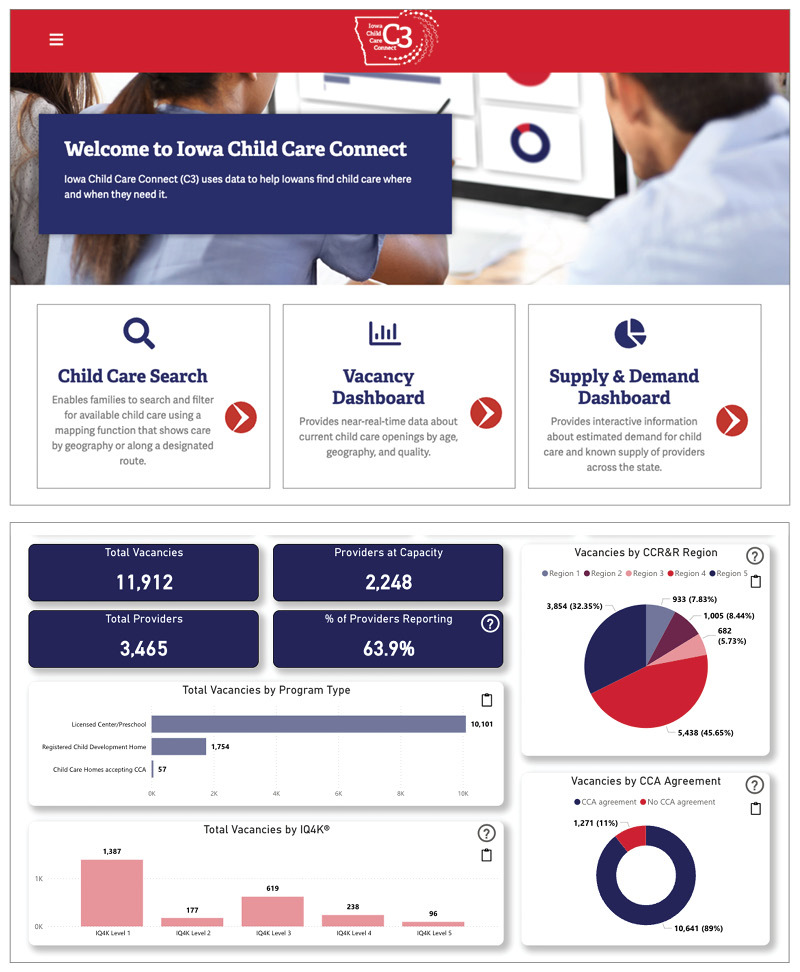
The Iowa Child Care Connect website and vacancy dashboard. Graphic by Deb Berger.
Heather Rouse and Todd Abraham -- along with their team at Iowa's Integrated Data System for Decision-Making (I2D2) -- helped the state of Iowa's Child Care Connect (C3) website launch in August, the first statewide effort in the nation to help families find near-real time child care vacancies in their area. It was an 18-month sprint for Iowa State and its partners, but Rouse, a human development and family studies associate professor, believes it's just the start.
"We are excited about what's next," she said. "Now that it is out there, we are looking for all the ways we can use the information to help the state."
C3 maps more than 3,000 child care providers across Iowa and lists information such as quality ratings, hours of operation, child age range served and whether they accept state child care assistance funds. Families can choose between home- and center-based child care and map out locations close to home or on a route to work or school. The site does not display the rates that providers charge, but has contact information for each business.
Rouse and her team knew how to build data systems and had agreements in place for data sharing, data storage and the staff to operate the new project. That head start saved more than two years in developing C3, she said.
Eight years ago, Rouse began the I2D2 project with Abraham, the assistant director of data and analytics. I2D2 is a partnership between ISU and state departments that combines data from education and health and human services for analytics and strategic planning to improve outcomes for Iowa children and families. It helps find gaps in services, measures the effectiveness of programs and informs policies that support children and families.
"When the governor's task force on child care provided recommendations for improving Iowa's child care system in 2021, several of the recommendations related to data and how to make information more readily available to families," Rouse said. "With what we had done with the I2D2 project, we already had the foundation of information we needed to start work on the Child Care Connect system."
The I2D2 team and ISU information technology services and information technology security partnered with the Iowa Department of Health and Human Services (HHS) and a technology consulting firm, Resultant, to build the site. Through a contract with the state, ISU maintains the data, technology infrastructure and website.
C3 draws significant interest from other states looking to do something similar, Rouse said. Iowa HHS leadership and the ISU team have presented on C3 at multiple conferences and fielded a plethora of questions about the process of building the website and its results.
Early results
The website receives hundreds of hits each month, with use steadily growing, Rouse said. C3 incorporates data from multiple sources including the state's licensing and registration data, child care management systems at each business and Iowa's Child Care Resourse and Referral network data system. Providers also can respond to a monthly reporting tool that updates their vacancy information by ages.
"The vacancy dashboard shows the number of providers who have submitted updated data," Rouse said. "We are seeing participation rates in the 60-70% range, and it is in their best interest to tell us when they have vacancies. If you don't communicate with the system within 60 days it assumes you are full. It's a way for them to advertise, and several have noted they are getting spots filled quicker."
Rouse said not only does C3 help ensure day care providers fill spots, but it helps communities and the state identify areas of need. The state has more than 177,000 children in child care.
The next level
A "wish list" is being compiled of possible expansions to the next version of C3. The team will meet next month with the work group that assisted through the planning and implementation phases of the website to discuss ways the system can be advanced.
"In all the work we do with our state partners, we try to think about how we can make an investment in something that will serve multiple purposes," she said. "So now the question is 'what else can it do?'"
